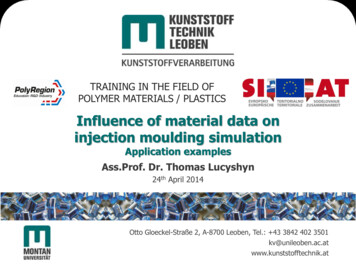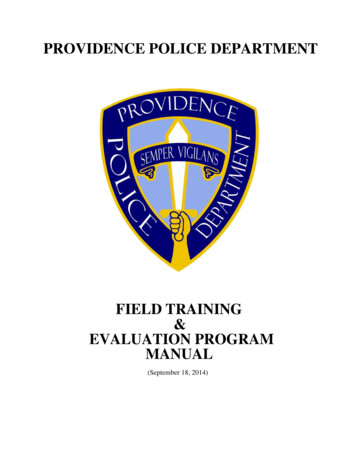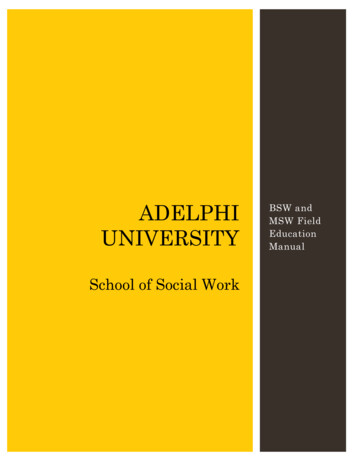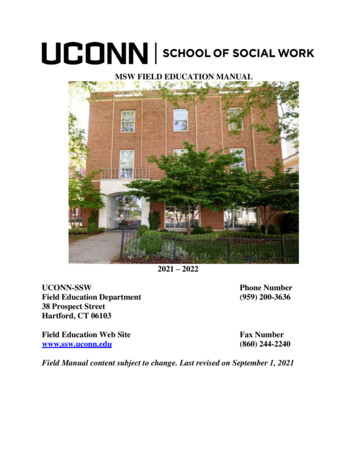
Transcription
TRAINING IN THE FIELD OFPOLYMER MATERIALS / PLASTICSInfluence of material data oninjection moulding simulationApplication examplesAss.Prof. Dr. Thomas Lucyshyn24th April 2014Otto Gloeckel-Straße 2, A-8700 Leoben, Tel.: 43 3842 402 3501kv@unileoben.ac.atwww.kunststofftechnik.at
Content IntroductionMelt Flow Rate (MFR) as reference value for viscosityPressure dependence of viscosityTransition temperatureThermal conductivity and specific heat capacitypvT-data at different cooling ratesSummarywww.kunststofftechnik.atThomas Lucyshyn2
Content IntroductionMelt Flow Rate (MFR) as reference value for viscosityPressure dependence of viscosityTransition temperatureThermal conductivity and specific heat capacitypvT-data at different cooling ratesSummarywww.kunststofftechnik.atThomas Lucyshyn3
Required material data Viscosity as a function of Shear rate, temperature and optionally pressure Transition temperature TtransThermal conductivity (ideally temperature dependent)Specific heat (ideally temperature dependent)pvT-dataMechanical properties Young s modulus, Poisson ratio, shear modulus, coefficientof linear thermal expansion Fibre propertieswww.kunststofftechnik.atThomas Lucyshyn4
Material data for injection moulding simulationSource: Internetwww.kunststofftechnik.atThomas Lucyshyn5
Content IntroductionMelt Flow Rate (MFR) as reference value for viscosityPressure dependence of viscosityTransition temperatureThermal conductivity and specific heat capacitypvT-data at different cooling ratesSummarywww.kunststofftechnik.atThomas Lucyshyn6
Measuring method of MFRNozzle:WeightWeight (mass):Shear stress:PistonSampleHeatingNozzleShear rate:MFR: Melt mass flow rate in g/10minViscosity:MVR: Melt volume flow rate in cm³/10minSource according to: Waßner, E.: Rheologische Grundlagen für die Auslegung von Extrusionswerkzeugen, VDI-Praktikum:Werkzeugauslegung mit Excel, Paderborn, 2003.www.kunststofftechnik.atThomas Lucyshyn7
MFR as reference value for viscosity?www.kunststofftechnik.atThomas Lucyshyn8
MFR for comparing materials?log Material AMaterial BMFRlog MFR of A MFR of BRheological behaviour of A Rheological behaviour of B?www.kunststofftechnik.atThomas Lucyshyn9
Example: pressure calculation at same MFR2 unfilled POM-grades of same supplierwww.kunststofftechnik.atThomas Lucyshyn10
Viscosity curves of the two POM-gradeswww.kunststofftechnik.atThomas Lucyshyn11
Part for simulationSquare box100 x 100 x 40 mm³ (1 mm wall thickness)www.kunststofftechnik.atThomas LucyshynHot runner withcentral gate at thebottom12
Pressure at swich over point (filling pressure)Hostaform s936325%1185 barwww.kunststofftechnik.atCelcon M50-141476 barThomas Lucyshyn13
Content IntroductionMelt Flow Rate (MFR) as reference value for viscosityPressure dependence of viscosityTransition temperatureThermal conductivity and specific heat capacitypvT-data at different cooling ratesSummarywww.kunststofftechnik.atThomas Lucyshyn14
Cross-WLF-equation in Moldflowwww.kunststofftechnik.atThomas Lucyshyn15
Cross-WLF-equation in Moldflow 0 0 1 1 n(8) A1 T T * 0 D1 exp A T T* 2 T * D2 D3 pA2 A2 D3 pPressure dependence!Approx. 8.800 thermoplastics in Moldflow 2014,of which about 100 materials with D3www.kunststofftechnik.atThomas Lucyshyn16
Cross-WLF-equation in Moldflowpressure 1 B0 C 1 n1 0temperature *www.kunststofftechnik.at 0A1-n 0Thomas Lucyshyn17
Part: thin walled bushInjection pressureat the injectionmoulding machine:2400 barWall thicknessabout 0,4 to0,8 mmwww.kunststofftechnik.atThomas Lucyshyn18
Measuring results of pressure dependent viscosityViscosity in Pa*s1000 bar1 barShear rate in s-1www.kunststofftechnik.atThomas Lucyshyn19
Calucations with and without pressuredependenceWithout pressure dependencewww.kunststofftechnik.atWith pressure dependenceThomas Lucyshyn20
Pressure at switch-over point (injection pressure)Without pressure dependence1284 barwww.kunststofftechnik.atWith pressure dependence85%Thomas Lucyshyn2368 bar21
Content IntroductionMelt Flow Rate (MFR) as reference value for viscosityPressure dependence of viscosityTransition temperatureThermal conductivity and specific heat capacitypvT-data at different cooling ratesSummarywww.kunststofftechnik.atThomas Lucyshyn22
Transition temperature (No-Flow)Experimental determination DSC-Measurement (Differential Scanning Calorimetry)In cooling mode at -20 K/minDetermination of the „onset temperature“ Capillary rheometer (not used any more)Melt polymer turn off heating piston with constant load squeeze out melt until strand speed 2mm/min (equals 0,033mm/s!) Further (less frequent) methods: Adapted injection moulding machine Pressure measurement at capillary rheometer Cone-plate-rheometerwww.kunststofftechnik.atThomas Lucyshyn23
Transition temperature with DSCDSC sample andreferenceoven chamberSource:Mettler Toledo AG, CHwww.kunststofftechnik.atThomas Lucyshyn24
Transition temp. of a semi-crystalline polymer8070Cooling mode60H (mW)50PPcooling rate -20 K/min40302010020406080100120140160180T ( C)Hostacom BR 735 G200Transition temperatureHeat flow H as a function of temperatureTSource: T. Lucyshyn, G. Knapp, M. Kipperer, C. Holzer: Determination of the Transition Temperature at Different Cooling Rates and Its Influence onPrediction of Shrinkage and Warpage in Injection Molding Simulation. Journal of Applied Polymer Science, 2012, 123, S.1162-1168.www.kunststofftechnik.atThomas Lucyshyn25
Transition temp. of an amorphous polymerCooling modeABS (cooling rate -20 K/min)Transition temperature(point of inflection)Source: T. Lucyshyn, G. Knapp, M. Kipperer, C. Holzer: Determination of the Transition Temperature at Different Cooling Rates and Its Influence onPrediction of Shrinkage and Warpage in Injection Molding Simulation. Journal of Applied Polymer Science, 2012, 123, S.1162-1168.www.kunststofftechnik.atThomas Lucyshyn26
Heat flux at different cooling rates for PP805 K/min10 K/min20 K/min40 K/min50 K/min7060H (mW)5040302010020406080100120140160180T ( C)Hostacom BR 735 G200Source: T. Lucyshyn, G. Knapp, M. Kipperer, C. Holzer: Determination of the Transition Temperature at Different Cooling Rates and Its Influence onPrediction of Shrinkage and Warpage in Injection Molding Simulation. Journal of Applied Polymer Science, 2012, 123, S.1162-1168.www.kunststofftechnik.atThomas Lucyshyn27
Transition temp. as a function ofcooling rate for PP410Ttrans405TtransTtrans (K)400 T a t 395ParameterPPHostacomBR 735 Ga (minbK(1-b))415,4385b (-)-0,0148380Correlationcoefficient R20,983390010203040506070Cooling rate (K/min)8090100110Hostacom BR 735 GSource: T. Lucyshyn, G. Knapp, M. Kipperer, C. Holzer: Determination of the Transition Temperature at Different Cooling Rates and Its Influence onPrediction of Shrinkage and Warpage in Injection Molding Simulation. Journal of Applied Polymer Science, 2012, 123, S.1162-1168.www.kunststofftechnik.atThomas Lucyshyn28b
Box for simulation and experiments100 x 100 x 40 mm³Source: T. Lucyshyn, G. Knapp, M. Kipperer, C. Holzer: Determination of the Transition Temperature at Different Cooling Rates and Its Influence onPrediction of Shrinkage and Warpage in Injection Molding Simulation. Journal of Applied Polymer Science, 2012, 123, S.1162-1168.www.kunststofftechnik.atThomas Lucyshyn29
Results for warpage simulation for PP4,03,5L1 experimentL2 experimentL3 experimentH1 experimentH2 experimentL1 simulationL2 simulationL3 simulationH1 simulationH2 simulationDeformation (%)3,02,52,01,5Box:1 mm wall thickness1,00,50,0102030405060708090100 110Cooling rate (K/min) Hostacom BR 735 G 3DSource: T. Lucyshyn, G. Knapp, M. Kipperer, C. Holzer: Determination of the Transition Temperature at Different Cooling Rates and Its Influence onPrediction of Shrinkage and Warpage in Injection Molding Simulation. Journal of Applied Polymer Science, 2012, 123, S.1162-1168.www.kunststofftechnik.atThomas Lucyshyn30
Content IntroductionMelt Flow Rate (MFR) as reference value for viscosityPressure dependence of viscosityTransition temperatureThermal conductivity and specific heat capacitypvT-data at different cooling ratesSummarywww.kunststofftechnik.atThomas Lucyshyn31
Thermal conductivityAmorphous eratur [ C]250Temperature ( ity (W/mK)Thermalconductivity (W/mK)[W/mK]WärmeleitfähigkeitSemi-crystalline tur [ C]Temperature ( C)250300Source: T. Kisslinger: Einfluss der thermischen Stoffdaten auf Berechnungsergebnisse in Moldflow Plastics Insight (MPI), Studienarbeit am Institut fürKunststoffverarbeitung, Montanuniversität Leoben, 2007.www.kunststofftechnik.atThomas Lucyshyn32350
Specific heat capacity (cp)Semi-crystalline thermoplasticsAmorphous thermoplastics160002500PPPA2000POM[J/KgK]cp Cp(J/kgK)Cp [J/KgK]cp 00250300350Temperatur [ C]Temperature( C)050100150200Temperatur [ C]250300Temperature ( C)Source: T. Kisslinger: Einfluss der thermischen Stoffdaten auf Berechnungsergebnisse in Moldflow Plastics Insight (MPI), Studienarbeit am Institut fürKunststoffverarbeitung, Montanuniversität Leoben, 2007.www.kunststofftechnik.atThomas Lucyshyn33350
Single values – temperature dependent values16000 Single value of specific heatat melt temperature(example for 300 Single value of thermalconductivity at melttemperature (example for PP)[W/mK]WärmeleitfähigkeitThermalconductivity (W/mK)Temperatur [ C]( 300Temperatur [ C]Temperature ( C)Source: T. Kisslinger: Einfluss der thermischen Stoffdaten auf Berechnungsergebnisse in Moldflow Plastics Insight (MPI), Studienarbeit am Institut fürKunststoffverarbeitung, Montanuniversität Leoben, 2007.www.kunststofftechnik.atThomas Lucyshyn34
Influence on cycle time Temperature of hottest region in part over time Time to reach ejection temperature evaluatedInvestigated regionof partSource: T. Kisslinger: Einfluss der thermischen Stoffdaten auf Berechnungsergebnisse in Moldflow Plastics Insight (MPI), Studienarbeit am Institut fürKunststoffverarbeitung, Montanuniversität Leoben, 2007.www.kunststofftechnik.atThomas Lucyshyn35
Influence on cycle timeTime (s)Example PP, 3 mm wall thicknessMesh variationsSource: T. Kisslinger: Einfluss der thermischen Stoffdaten auf Berechnungsergebnisse in Moldflow Plastics Insight (MPI), Studienarbeit am Institut fürKunststoffverarbeitung, Montanuniversität Leoben, 2007.www.kunststofftechnik.atThomas Lucyshyn36
Influence on cycle timeExample PS, 3 mm wall thickness35,0030,00λ(T) cp(T)λ(T) cp29,02λ cp(T)25,0025,02λ ,2815,0010,005,000,00PS Fusion 3mmPS 3D 3mmMesh variationsBerechnungsvariantenSource: T. Kisslinger: Einfluss der thermischen Stoffdaten auf Berechnungsergebnisse in Moldflow Plastics Insight (MPI), Studienarbeit am Institut fürKunststoffverarbeitung, Montanuniversität Leoben, 2007.www.kunststofftechnik.atThomas Lucyshyn37
Content IntroductionMelt Flow Rate (MFR) as reference value for viscosityPressure dependence of viscosityTransition temperatureThermal conductivity and specific heat capacitypvT-data at different cooling ratesSummarywww.kunststofftechnik.atThomas Lucyshyn38
pvT-dataAmorphous polymerSemi-crystalline polymerSpecific volume (cm³/g)Specific volume (cm³/g)meltmeltsolidsolidTransition temperatureTemperature ( C)Transition temperatureTemperature ( C)Source according to: Kennedy, P.: Flow Analysis of Injection Molds; Carl Hanser Verlag, München, 1995.www.kunststofftechnik.atThomas Lucyshyn39
Standard measurement method for pvT-dataCooling rate of approx.0,1 K/s (6 K/min)l r2v p, T mwww.kunststofftechnik.atThomas Lucyshyn40
high cooling rate (hcr) pvT-deviceIR-sensorThermocoupleOvenEjector pistonIR-sensorCooling rates up to15 K/sCooling channelsMeasuring cellStroke transducerPolymer sampleCooling channelsPistonPressure transducerin hydraulic systemSource: T. Lucyshyn: Messung von pvT-Daten bei prozessnahen Abkühlraten und deren Einfluss auf die Simulation von Schwindung undVerzug mit Moldflow Plastics Insight, Dissertation an der Montanuniversität Leoben, 2009.www.kunststofftechnik.atThomas Lucyshyn41
Results of hcr-pvT-device for ABS1,06ABSin cm³/gVolumen(cm³/g)SpezifischesSpecific volume1,041,02200 bar hcr-pvT400 bar hcr-pvT1,00600 bar hcr-pvTCa. 13 K/s800 bar hcr-pvT200 bar MPI0,98400 bar MPI600 bar MPI0,96Ca. 0,1 K/s800 bar MPI0,942,3 mmsample0,92050100150200250TemperatureTemperatur in( C) CSource: T. Lucyshyn: Messung von pvT-Daten bei prozessnahen Abkühlraten und deren Einfluss auf die Simulation von Schwindung undVerzug mit Moldflow Plastics Insight, Dissertation an der Montanuniversität Leoben, 2009.www.kunststofftechnik.atThomas Lucyshyn42
Results of hcr-pvT-device for 1,101,081,06400 bar hcr-pvT600 bar hcr-pvT1,04Ca. 15 K/s800 bar hcr-pvT1,02400 bar MPICa. 0,1 K/s600 bar MPI1,00800 bar MPI0,980,962 mmProbe0,94050100150200250Temperatur CTemperaturein( C)Source: T. Lucyshyn: Messung von pvT-Daten bei prozessnahen Abkühlraten und deren Einfluss auf die Simulation von Schwindung undVerzug mit Moldflow Plastics Insight, Dissertation an der Montanuniversität Leoben, 2009.www.kunststofftechnik.atThomas Lucyshyn43
Simulation results for ABS2,01,8Deformation in %1,61,41,21,00,8Standard edimensionsVergleichsmaßeABS, 3D-ModelSource: T. Lucyshyn: Messung von pvT-Daten bei prozessnahen Abkühlraten und deren Einfluss auf die Simulation von Schwindung undVerzug mit Moldflow Plastics Insight, Dissertation an der Montanuniversität Leoben, 2009.www.kunststofftechnik.atThomas Lucyshyn44
Simulation results for PP2,01,8Deformation in %1,61,41,21,00,8Standard e dimensionsVergleichsmaßePP, 3D-ModelSource: T. Lucyshyn: Messung von pvT-Daten bei prozessnahen Abkühlraten und deren Einfluss auf die Simulation von Schwindung undVerzug mit Moldflow Plastics Insight, Dissertation an der Montanuniversität Leoben, 2009.www.kunststofftechnik.atThomas Lucyshyn45
Content IntroductionMelt Flow Rate (MFR) as reference value for viscosityPressure dependence of viscosityTransition temperatureThermal conductivity and specific heat capacitypvT-data at different cooling ratesSummarywww.kunststofftechnik.atThomas Lucyshyn46
Summary 1 Complex material data required for simulation Melt Flow Rate (MFR) as reference value for viscosity? Good orientation for limitation of potential similar materials Important: compare viscosity curves! Example: pressure difference of 25% at same MFR Pressure dependence of viscosity Viscosity increases with increasing pressureEspecially important for thin walled partsRelevant at expected injection pressures 1000 barExample: pressure difference of 85%www.kunststofftechnik.atThomas Lucyshyn47
Summary 2 Transition temperature Determined with DSC measurement Cooling rate has influence on transition temperature Transition temperature has influence on warpage results Temperature dependent thermal data Significant differences between single point data and temperaturedependent data Especially cycle time differs by up to 15% pvT-data Cooling rate has influence on pvT-curves Improved shrinkage simulation with pvT-data obtained at processnear cooling rateswww.kunststofftechnik.atThomas Lucyshyn48
Thank you for your attention!Contact:Ass.Prof. Dr. Thomas LucyshynChair of Polymer ProcessingMontanuniversitaet LeobenOtto Gloeckel-Str. 28700 Leoben03842 / 402 – echnik.atThomas Lucyshyn49
Source: T. Kisslinger: Einfluss der thermischen Stoffdaten auf Berechnungsergebnisse in Moldflow Plastics Insight (MPI), Studienarbeit am Institut für Kunststoffverarbeitung, Montanuniversität Leoben, 2007. 0 4000 8000 12000 16000 0 50 100 150 200 250 300 350 Temperatur [ C]] PP PA POM 0 500 1000 1500 2000 2500 0 50 100 150 200 250 300 350 .











